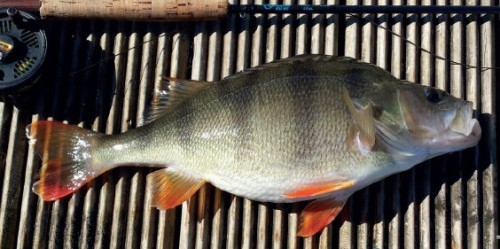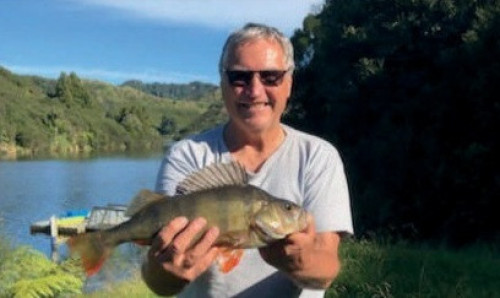Please select here to view information below as pamphlet.
Redfin Perch (Perca Fluviatilis)
Although often overlooked, targeting perch can be an exciting and rewarding experience for anglers of any skill level. The Taranaki region possesses several excellent perch fisheries so here are some key tips & tricks to targeting them, alongside locations where they can be found - take your pick, plan a trip, and get out there!

How do I target perch?
One of the most popular methods for catching perch in Taranaki is by using soft baits. A variety of colours and sizes will work, but as a standard, a 7cm paddle tail with brighter colours (yellow, orange, pink) is a great starting point. Spinners will also work well - colourful, reflective mepps and veltec spinners have proven their worth, alongside tasmanian devils and tobys which can elicit aggressive takes by perch of all sizes. Perch will also readily attack a bait (i.e. worm or prawn) fished from the bottom or suspended under a float with a meter or so of trace. In terms of fly fishing, a wide range of lures will work, with popular examples including Mrs Simpson and woolly bugger patterns.
Can you eat them?
Yes! Perch are regarded as an excellent eating fish, they possess a firm, tasty white fillet similar to snapper that can be prepared in a variety of ways such as baking, grilling, deep or pan frying. The fillets also freeze quite well.

Where can I find them?
Perch prefer areas of slower moving and still water hiding amongst structures, such as weeded edges, overhanging vegetation, and piers. Juvenile perch will often school and feed together meaning if you catch one in a particular spot, there are likely to be more. Adult perch become more solidary in their behaviour and feeding habits.
Targeting perch within still water fisheries is often a good compromise when river flows are too high to enable fishing.
Lake Rotomanu
Lake Rotomanu has a productive urban perch fishery offering a great experience for local anglers. The lake has excellent access around its whole margin, with a jetty and two dedicated casting platforms making a great spot for a family fishing adventure. Colourful soft baits and spinners consistently prove their worth here.
Lake Ngangana (Waitara)
Located next to the Taranaki kart club track at the end of Joll Street, Waitara, this 4-hectare lake holds a good population of perch. There is a walking track along the adjacent Waitara riverbank that gives access to some suitable fishing sites, although the grassed area at the northern end of the lake provides easiest access. Turn east into princess street off sh3 just north of the Waitara river bridge and take the first right into Joll Street. The lake margins have large amounts of overhanging vegetation that perch inhabit, focusing on directing casts towards these areas may help to grab their attention.
Lake Ratapiko
Located just 12km from Inglewood and 9km down Tariki Road, Lake Ratapiko is a large and shallow hydro lake covering almost 27 hectares. There is great access for fishing along Ratapiko Road, where anglers can target perch as well as brown and rainbow trout. Anglers will find success using spinners and soft baits with fast retrievals to keep lures above weed lines. Note: the lake is closed to fishing for the month of may each year for duck hunting.
Lake Rotokare
Surrounded by a beautiful pest-free nature reserve managed by the Rotokare scenic reserve trust, Lake Rotokare holds some large (1.5kg+) perch. There is excellent fishing access along the grassy margins near the boat ramp, and a wheelchair accessible pontoon situated along the public walkway. Between December and April, powered watercraft are allowed on the lake while non-powered craft such as kayaks are welcome year-round, just be sure to check-clean-dry any watercraft and equipment before you bring it to the lake. Kayak fishing for perch has proven to be a successful pursuit at Lake Rotokare, enabling anglers to stealthily cast onto weed lines and deeper areas inaccessible from land. Note: please leave all pets at home if you are planning a visit. Anglers are reminded that eel fishing is not allowed here.
Lake Rotorangi
Lake Rotorangi is the largest lake in the Taranaki region, formed in 1984 by the damming of the lower Patea River. It is almost 46 kilometres in length and runs through beautiful hill country. Public access to the upper reaches is via Anderson/Rawhitiroa Road at Eltham, which winds 24 kilometres to a good boat ramp at Glen Nui. The middle reaches of the lake are accessed via Tawhiti, Ararata and Tangahoe Valley Roads, which take you to the Pukekino landing water ski area. The lower reaches can be accessed via upper ball road off state highway 3, south of Hawera.
Each of these access points lead to large areas of open shoreline where perch can be targeted. Casting soft baits, spinners, and bait fishing from boats and kayaks will provide great results, especially when fishing near overgrown or weedy shorelines only fishable from the water, or jigging in deeper water.
Lower Patea River
The lower Patea river is less well known, but is a great location to target large perch with soft baits and spinners. Access to the lower Patea is via Maben Road, which connects to ball road, off state highway 3. The McColl’s have kindly permitted anglers to cross private land from Maben Road to access the river - but please respect the fact that this is private property and a functioning farm. Do not park in gateways and strictly no dogs.
Lake Wiritoa
Lake Wiritoa is a 5-hectare coastal dune lake located 5 minutes south of Whanganui that offers easy access to some great perch fishing. Accessed from Kaitoke road, family-friendly fishing spots include the lake edge at the ski clubrooms (where you first arrive at the lake) or at Scoutland’s Beach (at the end of the tar-sealed road around the lake). Bait fishing with bubble floats and worms, or spin fishing using colourful veltec, mepps, or soft baits is recommended. A ramp is available for boat launching, although it is generally best to avoid peak times as jet and water ski enthusiasts also use the lake.
Lake Kohata
Located adjacent to Lake Wiritoa, this secluded lake also supports a fishery for good-sized perch. To access the lake, park at Lake Wiritoa in the vicinity of the last houses along the northern shoreline and cross the fence using the style beside the Lake Kohata sign. A 10-minute walk along the fence line will bring you to the lake, with the easiest access existing along the low-lying eastern shoreline. Anglers can walk right round the lake, but must stay within the reserve boundary, located 20 metres from the water’s edge. Bait fishing or spinning with colourful lures and soft baits is worthwhile here. In recent years the invasive weed hornwort has proliferated in the lake and can interfere with angling at times.
Coastal Dune Lakes
Many of the Coastal Dune Lakes located between Hawera and Whanganui (e.g. Nowell’s Lakes) hold perch. Some of these lakes go into algal bloom at times, but at other times have good water clarity and can be worth a visit. Most lakes are accessed via private land, and landowner permission must be obtained.